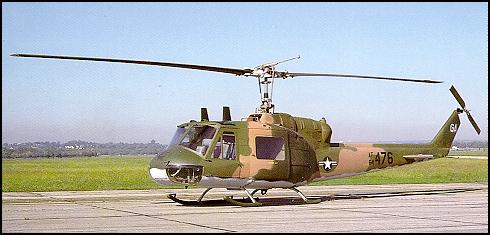
AvStop Magazine Online
BELL UH-1P "IROQUOIS"

The UH-1 evolved from a 1955 Army competition for a new utility helicopter. The Army employed it in various roles, later including that of an armed escort or attack gunship in Vietnam. The USAF, USN, and USMC eventually adopted the model as did Canada, Brazil, and West Germany. The initial Army designation was HU-1, which led to the common unofficial nickname of "Huey." It was redesignated in 1962 as the UH-1 under a triservice agreement. SAF orders for the Huey began in 1963 for UH-1Fs, intended for support duties at missile sites, and for TH-1Fs for instrument and hoist training and medical evacuation.
The HH-1 H incorporated a longer fuselage and larger cabin for a crew of two and up to eleven passengers or six litters. The USAF ordered these in 1970 as local base rescue helicopters to replace the HH-43 "Huskie." The first of the USAF's UH-1Ns, a twin-engine utility version capable of cruising on one engine, was obtained in 1970. The Huey on display served in South Vietnam in 1968-71 with the 20th Special Operations Squadron. In June 1969, its designation was changed from UH-1F to UH-1P, one of a few -Fs modified for a classified psychological warfare role. It was flown to the USAF Museum in April, 1980.
SPECIFICATIONS
Rotor Diameter: 48 ft. 0 in.
Overall Length: 57 ft. 0 in.
Height: 14 ft. 11 in.
Weight: 9,000 max.
Armament: None
Engine: General Electric T-58 of 1070 shaft hp.
Cost: $273,000
Crew: One or two
PERFORMANCE
(UH-1F)
Maximum speed: 140 mph.
Cruising speed: 115 mph.
Range: 330 miles
Service Ceiling: 24,830 ft.